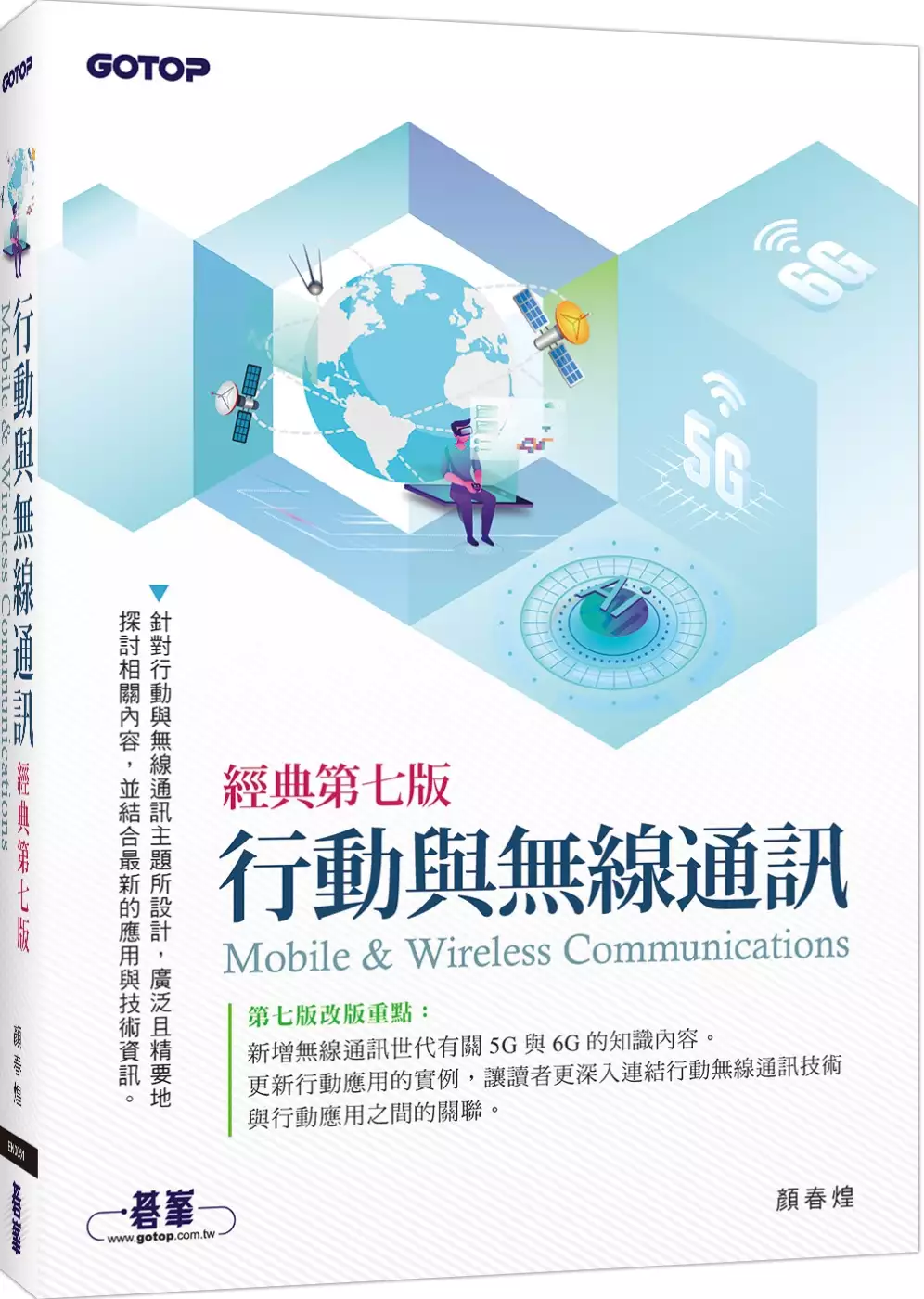Broadband access的問題,透過圖書和論文來找解法和答案更準確安心。 我們找到下列免費下載的地點或者是各式教學
Broadband access的問題,我們搜遍了碩博士論文和台灣出版的書籍,推薦顏春煌寫的 行動與無線通訊(經典第七版) 和Hinton, Kerry James,Ayre, Robert,Cheong, Jeffrey的 Modeling the Power Consumption and Energy Efficiency of Telecommunications Networks都 可以從中找到所需的評價。
這兩本書分別來自碁峰 和所出版 。
元智大學 電機工程學系乙組 邱政男、陳興義所指導 陳昱翔的 具有信號全通傳輸的超寬頻雙向吸收型共模濾波器 (2021),提出Broadband access關鍵因素是什麼,來自於共模濾波器、差動傳輸線。
而第二篇論文輔仁大學 應用科學與工程研究所博士班 劉惠英所指導 許哲榮的 機會路由於無線網路之研究 (2021),提出因為有 機會路由、多通道、無線網路的重點而找出了 Broadband access的解答。
行動與無線通訊(經典第七版)

為了解決Broadband access 的問題,作者顏春煌 這樣論述:
國內行動與無線通訊(Mobile & Wireless Communications)長銷經典書籍! 完全針對行動與無線通訊主題所設計,廣泛且精要地探討相關內容,並結合最新應用與技術資訊。 最新第七版改版重點: ■擴充行動無線通訊世代有關於5G與6G的介紹,闡述設計上的考量。 ■新增無線通訊的應用實例,包括星鏈(SpaceX)、Uber叫車、物聯網、行動支付、無人超市與智慧城市等。 ■更新有關於無線區域網路(WLAN)協定的介紹,涵蓋Wi-Fi6與IEEE 802.11ax。 ■因應行動支付的趨勢,擴充短距離無線通訊技術的介紹。 本書
特色 ■解開電磁波的迷思:無線通訊帶來的方便是大家所喜愛的,但是電磁波的生物效應卻也是眾人的隱憂,所以建立正確的認知是很重要的。 ■通訊的原理:詳細介紹訊號(signal)、調變(modulation)與多重存取(multiple access)技術有詳細的介紹,樹立通訊原理的專業背景。 ■認識無線通訊的術語:行動與無線通訊裡的專業術語多而分岐,像1G、2G、3G、4G、5G與6G代表什麼?合作式通訊與中繼技術有什麼用途?什麼是無線寬頻(WiBB,Wireless Broadband)上網?書中都有清楚的解說。 ■了解無線通訊的環境:生活環境中,經常看得到天線;但是我們
可能很少去注意。本書提供基地台、無線基地台與天線塔台等無線通訊設施的圖片與解說,以及無線通訊改良工程的介紹,引導了解這些生活中的鄰居。 ■行動與無線通訊的應用:您可能常會聽到,但卻不一定了解,本書介紹相關應用與開發技術,如SMS、MMS、MVPN、公眾無線區域網路(Public Wireless LAN) 、WiMAX、LTE、NFC、RFID、行動定位與行動商務等主題。 ■行動與無線通訊的資安問題:闡述KRACK對於WPA2安全協定的威脅。深入說明行動化安全防護的問題,如:BOYD、CYOD與COPE的使用導入模式,以及MDM與MAM等行動載具的安全管理機制。 ■行動與無線
通訊的相關技術、環境以及應用開發:大家一定都聽過APP,或是雲端服務,這些新發展都跟行動與無線通訊技術有關。 ■書前提供課本導讀,可以在正式學習前,就有全盤的概念及學習方向;而書末則附有完整索引及無線通訊辭典,方便快速查詢專有名詞、術語與概念。 ■內文適時補充相關知識、新訊與思考活動,能增加學習廣度;而章末另附常見問答集及自我評量,可供分組互動或進行練習。
具有信號全通傳輸的超寬頻雙向吸收型共模濾波器
為了解決Broadband access 的問題,作者陳昱翔 這樣論述:
本文提出了新穎的缺陷接地結構 (DGS) 的吸收式共模濾波器。前期研究微帶線吸收式共模濾波器,擁有一個超寬的共模雜訊吸收頻帶,頻寬百分比高達131%,且由 3-dB決定的差模訊號截止頻率高達17 GHz。接著透過前期研究延伸,提出帶線超寬頻吸收型共模濾波器,將其共模雜訊吸收頻寬百分比提升至 147%。此外,濾波器由 3-dB 截止頻率決定的差模信號總傳輸頻率高達約 15 GHz,並將濾波器尺寸縮小至1.1%。共模雜訊吸收頻寬和信號傳輸頻寬的表現在過去的文獻中從未實現過。
Modeling the Power Consumption and Energy Efficiency of Telecommunications Networks

為了解決Broadband access 的問題,作者Hinton, Kerry James,Ayre, Robert,Cheong, Jeffrey 這樣論述:
Kerry HintonKerry Hintonreceived an Honours Bachelor of Engineering in 1978, an Honours Bachelor of Science in 1980 and Master of Science Degree in Mathematical Sciences in 1982, all from the University of Adelaide. He was awarded a Ph.D. in Theoretical Physics from the University of Newcastle Upon
Tyne, U.K., and the Diploma in Industrial Relations from the Newcastle Upon Tyne Polytechnic, U.K., in 1984.In 1984 Dr. Hinton joined Telstra Research Laboratories (TRL), Victoria, Australia, where he worked on analytical and numerical modelling of optical systems and components. His work focused op
tical communications devices and architectures, physical layer issues for Automatically Switched Optical Networks (ASONs) and monitoring in all-optical networks. From 1998 until 2010 Dr. Hinton was a sessional lecture for the Master in Telecommunications Engineering course at the University of Melbo
urne.In 2006, Dr. Hinton commenced as a Senior Research Fellow in the CUBIN, at the University of Melbourne, Australia. In 2011 Dr. Hinton joined CEET as a Principal Research Fellow researching the energy efficiency of the Internet, communications technologies and networks. Robert AyreRobert Ayre wa
s awarded the degree of Bachelor of Science (with Distinction) from George Washington University in 1967, and the degrees of Bachelor of Engineering (with Honours) and Master of Engineering Science from Monash University in 1970 and 1972 respectivelyIn 1972 Mr. Ayre joined (what was to become) Telst
ra Research Laboratories (TRL). At TRL, he worked principally on optical transmission systems and networks, beginning with the earliest metropolitan multimode fibre systems through to long-haul optically amplified WDM systems. He was involved with Telstra’s Engineering teams on optical network plann
ing and in the first deployments of each of the new generations of optical transmission technologies. He also represented Telstra in the International Telecommunications Union Study Group XV on standards for optical transmission systems, and the International Electrotechnical Commission in developin
g standards for Laser Safety in Optical Communications Systems. Over time, he became responsible for a number of TRL’s infrastructure development teams, covering Access networks, Core Transmission Networks, Data Networks, and Internet Services. Following the closure of TRL, in 2007 he joined the Cen
tre for Ultra Broadband Networks, (CUBIN) which later became the Centre for Energy Efficient Telecommunications, (CEET), at the University of Melbourne as a Senior Research Fellow. Jeff CheongJeff Cheong was awarded the degrees of Bachelor of Engineering (Honours) and Ph.D. from Monash University in
1976 and 1983 respectively. He then joined the Telstra Research Laboratories (TRL) in 1983. During his career with TRL (1983 - 2006), Dr. Cheong led TRL in the development of control and signalling systems to facilitate the introduction advanced Intelligent Network (IN) PSTN services, service assur
ance systems for the rollout of VoIP and performance and monitoring tools for Telstra online services. He was also involved in the standardization of ITU-T Intelligent Network Capability Set 1 standards and the application of these standards for services rollout.Dr Cheong previously held appointment
s with the University as Senior Research Fellow in CEET and the Institute for a Broadband-Enabled Society (IBES) (2013- 2014). In IBES he developed models for costings of fibre and civil infrastructures to support a National Broadband Network based on FTTP and for also fixed wireless technology. His
research in CEET involved the modelling of energy efficiency of 3GPP LTE networks, the development of the GreenTouch Consortium’s Mobile Communications WG Architecture, and development of models for quantifying energy savings of distributed vs. centralised mobile network architectures. His current
research includes development of analytical models for quantifying the performance of broadband access networks and the dimensioning of these networks.
機會路由於無線網路之研究
為了解決Broadband access 的問題,作者許哲榮 這樣論述:
機會路由(OR)是一個新興的概念,它可以善用無線通訊的廣播特性。透過動態選擇路由路徑,機會路由可以大幅增加無線網路的傳輸品質與效能。此外,機會路由的概念還能套用至所有的多跳無線網路(multi-hop wireless networks)。雖然機會路由很有潛力,它仍在發展階段。這篇論文調查了目前的機會路由方法與現況,並專注於三個方面:1)協調機制,2)路由表,3)傳輸速度控制。協調機制的主要目的是收集確認(acknowledgments),並且為機會路由的主要核心。目前的主要協調方法為偷聽(overhear),有著低成本與高代價,且被限制在單一通道的環境下。透過理論分析與模擬結果,這篇論文證
實了目前的偷聽協調方法是有著高代價且該代價會隨著環境增加(unscalable)。因此,這篇論文提出了令牌傳遞(token passing)的協調機制,該機制有著低成本與低代價,且適用於多重通道的環境,讓它能成為後續研究的雛型。透過模擬實驗證實,令牌傳遞的協調機制可以加倍效能並降低一半的成本。機會路由的路由表與一般不同,容易因為節點的負載不平均且而造成瓶頸。本論文提出了一個挑選路由的評量方法(routing metric),該評量方法會給予高負載的狀況懲罰,進而挑出瓶頸較小的路由,並增加25%效能。關於傳輸速度控制,目前點對點的機制(如TCP)無法辨別壅塞與封包遺失,因此不適於無線網路。本論文
則提出一個方法,可以計算來源端的上限速度,讓瓶頸不至於壅塞,進而增加35%效能。